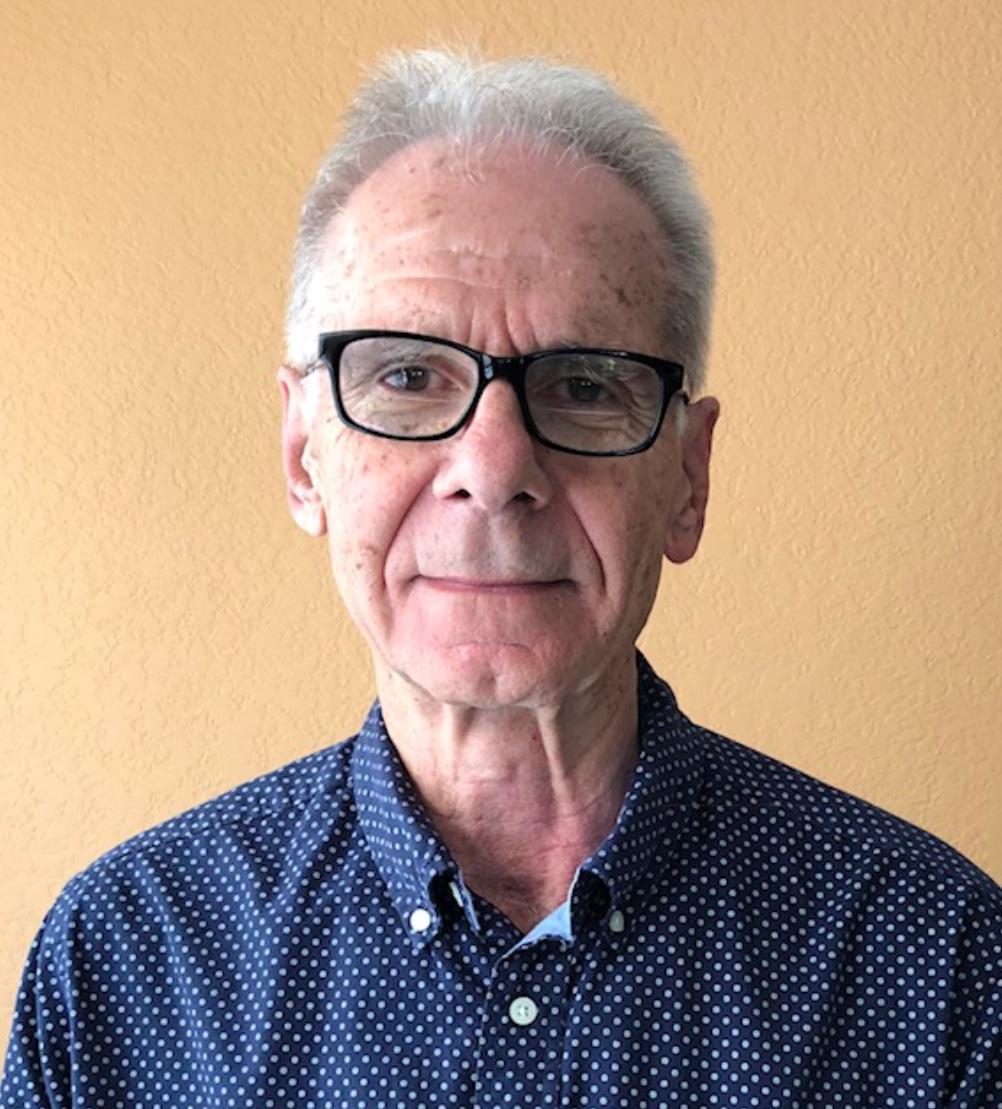

The Hub Loans Incident was the Largest Police Shootout in American History at the Time

When he arrived in the pouring rain, officers were already firing their weapons into the store and after giving Brown a shotgun, told him that there might be more than one gunman inside.
Needing a protective barrier for officers outside the Hub, a large Coke truck was commandeered and parked along Fifth Avenue. To break the pawnshop’s heavy plate glass windows for tear gas to be used, officers flung quart-sized bottles of Coke to through the windows. All the while, with an unlimited supply of weapons and ammunition, Anderson kept firing at officers from several second story windows.
Police did not know if the pawnshop’s manager, Louis Richards, who was lying face down at the front entrance was dead or alive. Sergeant Brown volunteered to find out and after strapping a makeshift steel plate over his uniform shirt as a bulletproof vest, Brown reached Richards and dragged him to the sidewalk.
Although the manager was dead, several officers sneaked along the Fifth Avenue side of the store and with Brown’s help were able to place the dead man on a gurney and roll it to a waiting ambulance.
Providing cover were officers from several angles, including Sergeant Sam Chasteen who was armed with a Thompson sub machine gun. At one point, a call was sounded that Chasteen had been wounded in the forehead. He was quickly taken away in a squad car. Later it was determined that after ducking gunfire, he struck his head on a steel pipe that had a protruding bolt.
As the battle raged on, officers coming to the scene would drive up, get out, fire their weapons into the building and when all their ammunition was used up, get back in their car and drive away.
A retired Emmy Award winning newsman, John Culea based his 12th book, his first non fiction, on the 1965 Hub Loans Company shootout.
Through exhaustive research and interviews with those who were there, Mr. Culea narrates how the Hub Loans aftermath ushered in the creation of one of America's first Special Weapons and Tactics (SWAT) Team.
Mr. Culea currently enjoys his retirement in San Diego.
Hub Loans Shootout
By John Culea
On April 8, 1965, the San Diego Police Department was about to change as never before. Shortly after 10 a.m., 28-year-old Robert Page Anderson walked into the Hub Loans and Jewelry Company on the corner of Fifth and F Street. Supposedly, he was downtown to see a movie but it did not start until later.
Greeted by Hub manager Louis Richards, Anderson after trying to pawn a diamond ring that would only give him $10, asked to see a 30.06 rifle with a telescopic sight and ammunition. Richards summoned his clerk, Ted Sweinty who handed the rifle and ammunition to Anderson.
When Anderson began loading the rifle, Sweinty objected but Anderson said he was going to “blow your brains out.” After Richards told Anderson he could take the rifle and leave, Anderson pointed the rifle at the manager who tried to run away but was shot in the back. Swienty then raced upstairs and hid. Anderson, on probation for marijuana possession saw no way out.
At that moment, Sergeant Allen D. Brown who had been on duty since 3 a.m. was finishing reports eight blocks away at headquarters when he heard about the shooting. He immediately got in his police car and headed downtown.
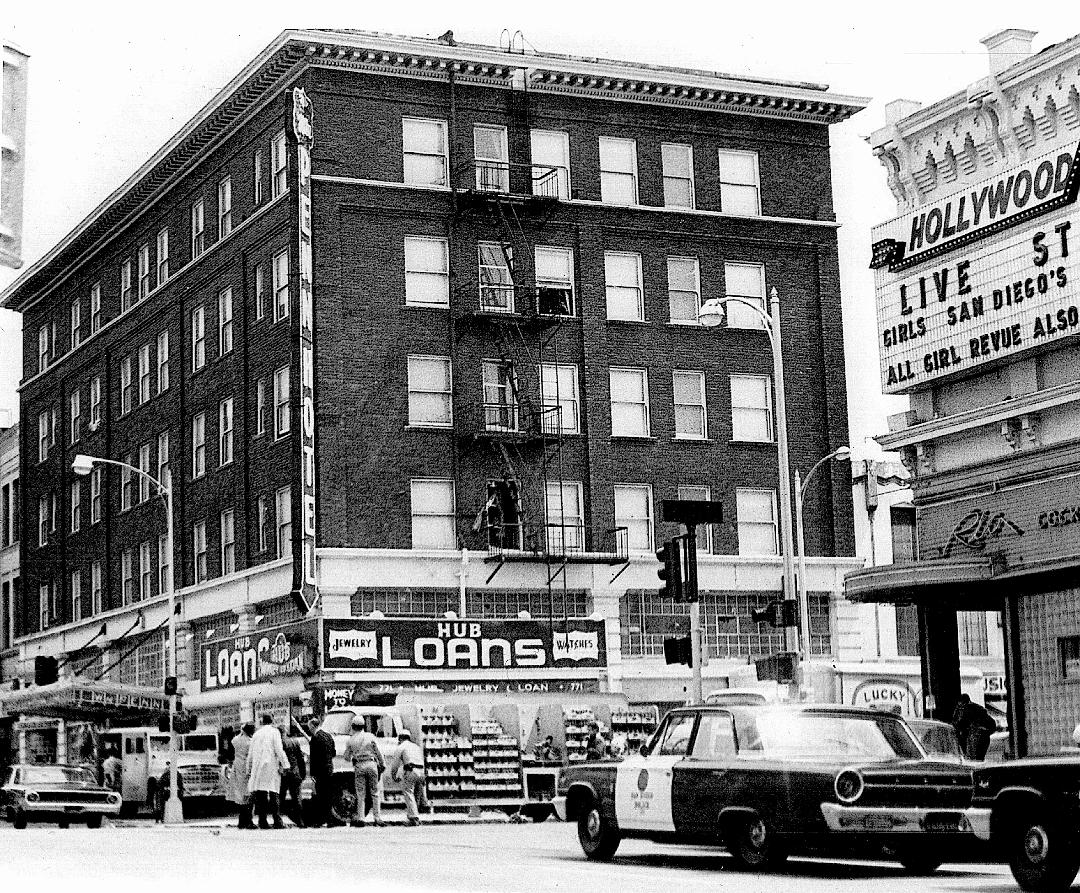
The corner of Fifth and F with Hub Loans and the William Penn Hotel behind a commandeered Coke delivery truck used for cover for officers. An armored car is parked on the sidewalk along the west side of the Hub
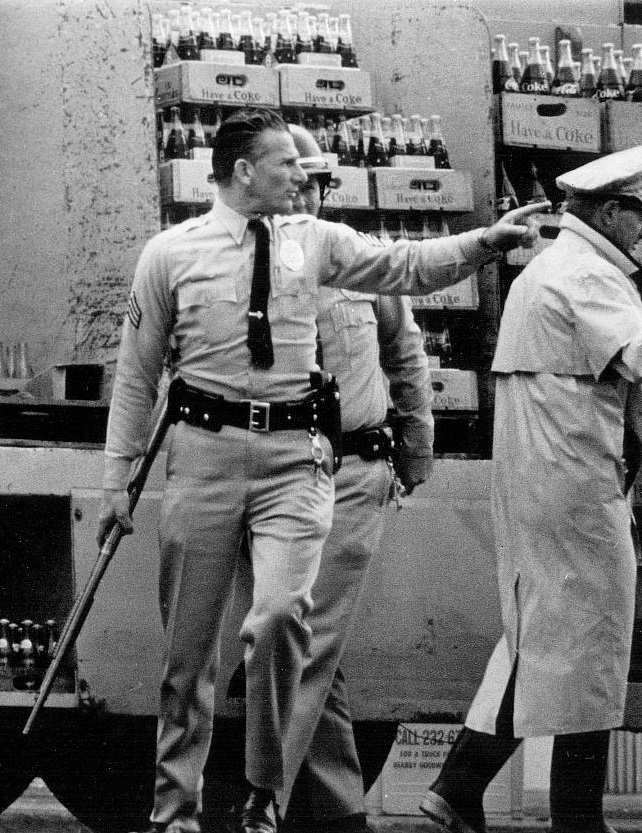
Sergeant Allen Brown positioning his men before leading the
assault on the suspect.
Some members of the media were able to get close to the scene and crouched next to police cars alongside officers. One of them was 52-year-old Frank Crandall, editor of a small newspaper, the San Diego Independent. He never was able to write his report. After getting to a nearby sidewalk he fell over dead. At first it was thought a stray bullet had hit him. A newspaper photographer and a police officer draped Crandall over the shoulder of the photographer and carried him away. It was later discovered he died of a massive heart attack. An hour earlier he had received a letter advising him his wife was divorcing him.
By this time, officers needed to get closer to the pawnshop, so a Loomis armored car was brought in and parked along the Fifth Avenue side of the building.
Police peppered the inside of the store from the armored car’s gun ports blowing apart everything inside. Although the armored car was bulletproof, it was not tear-gas proof.
A wind shift during the rainstorm blew tear gas from inside the pawnshop into the armored car, driving officers from inside the vehicle to the street.
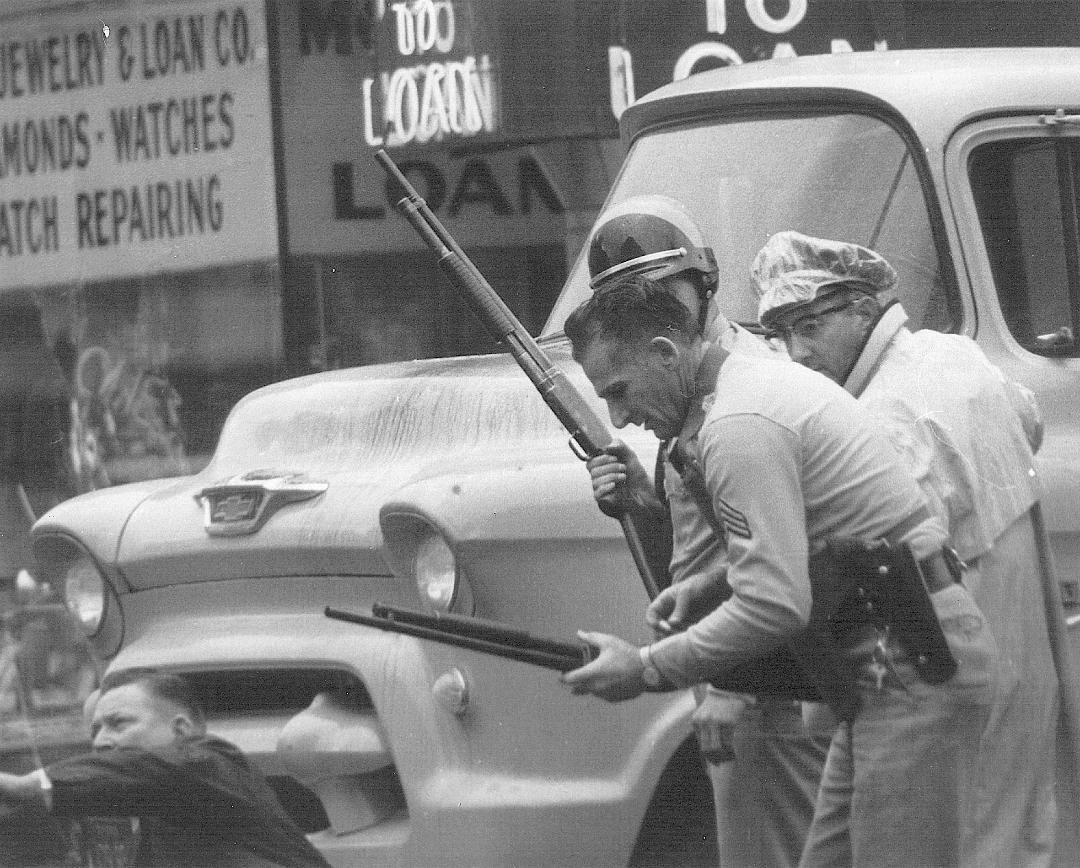
Sergeant Brown’s son, Frank remembers the Hub shootout. He was at the police academy on that day learning how to be a cop. When he saw his father back at headquarters, soaking wet, Frank Brown went to him and while giving him a hug said, “I knew you could do it, dad. You always were bullet proof.”
That night, Sergeant Brown and his wife Vera were shown live on KOGO-TV Channel 10’s eleven o’clock news. Despite all that he had done, Brown was not given the next day off and had to be back in uniform and at work at 3 a.m. Stress leave for officers involved in traumatic situations was still a long way off.
Allen Brown went on to become a lieutenant and formed the department’s first Special Weapons and Tactics (SWAT) unit. He retired in 1974 and in 1995 at a long overdue ceremony was presented the department’s Medal of Valor, the highest award that can be given to an officer and only for cases of extreme bravery.
At that ceremony, told he had just 30 seconds to say something he looked at the crowd and said, “People always ask me if I was scared that day. I’m a WWII veteran. I wasn’t scared. I was pissed off. That guy had my men pinned down and someone needed to take him out. So I took him out.” Then he walked off the stage. The entire crowd was on its feet cheering.
Sergeant Allen Brown, with a steel plate strapped to his uniform shirt, loads his rifle
before approaching the front entrance to see if Hub manager, Louis Richards was alive.
Sergeant Allen Brown in front of the Hub entrance will soon realize Richards was dead but pulled the dead man’s body to the sidewalk
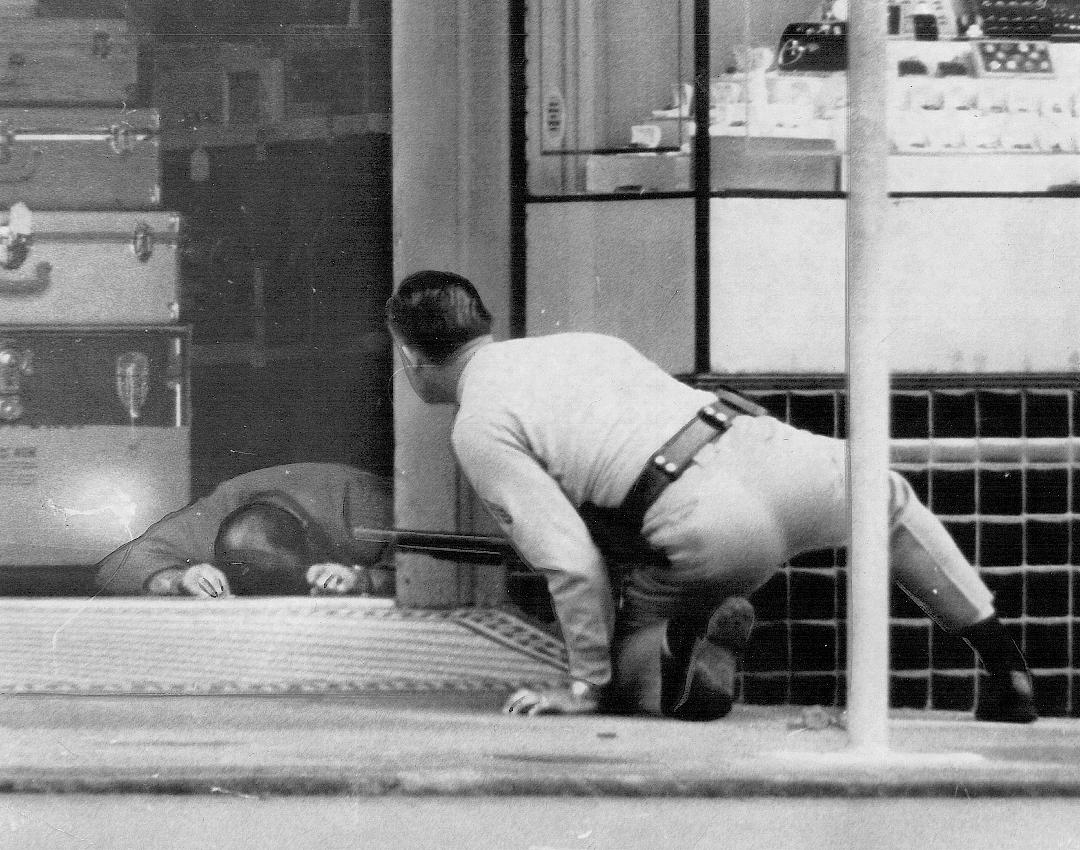
Pleas over a bullhorn by Inspector Wayne Colburn for Anderson to surrender were answered with gunfire. It was then that police called on the Navy for assistance in either driving the gunman outside or killing him.
Responding was Gunner’s Mate Third Class Frank Morales who arrived with concussion hand grenades. At first, police wanted Morales to teach them how to use the hand grenades but on second thought, decided it was best to let him do the job. It took two grenades, the second one wiping out much of the second floor mezzanine.
At this point, Sergeant Brown and fellow officers walked into the smoke-filled first floor that was still heavy with tear gas. Unknown to anyone was that Hub clerk Ted Swienty was hiding under a bed in a second floor room with blacked out windows from World War II. Swienty had held his breath when he heard Anderson come into the room but he could not find him.
With Anderson upstairs refusing to surrender, Sergeant Brown volunteered to go up the stairway to get him. With officers behind him, Brown, armed with a shotgun slowly walked along a dark hallway.
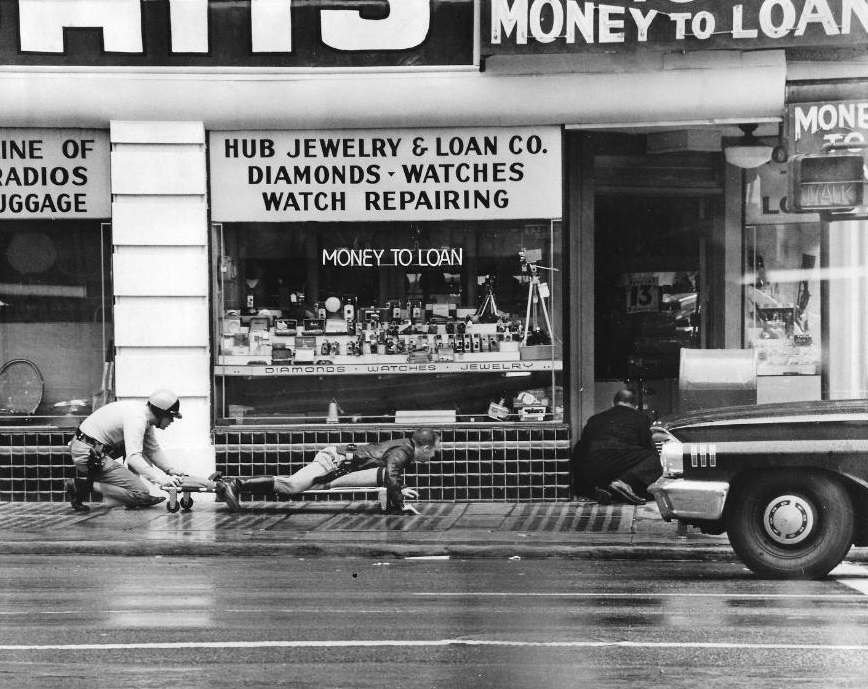
Just then he heard “click, click.” Anderson had jumped out from a hiding place and was pulling the trigger on a handgun. The clicking was the gun hammer hitting the cartridges in the gun, but Anderson had loaded the pistol with the wrong ammunition. Sergeant Brown immediately fired his shotgun four times, blasting Anderson in the abdomen and both arms. It was over.
Anderson was put on a stretcher and taken to County Hospital where he underwent five hours surgery. He recovered but lost the use of both arms.
For the murder of Louis Richards, the attempted murder on three police officers and robbery, Anderson was convicted and after a second penalty-phase trial, was sentenced to death. In 1972, his case on appeal resulted in the Supreme Court of the State of California ruling capital punishment unconstitutional. Anderson’s sentence, along with fellow death row inmates Charles Manson and Sirhan Sirhan was commuted to life in prison with the possibility of parole. Anderson was paroled in 1976 and moved to Seattle, Washington where he died in 1999 at age 62.
Officer Orv Hale (left) and an unidentified motorcycle patrol officer push a police
ambulance gurney under the Hub window to reach the body of slain
Hub Loans manager Louis Richards.
